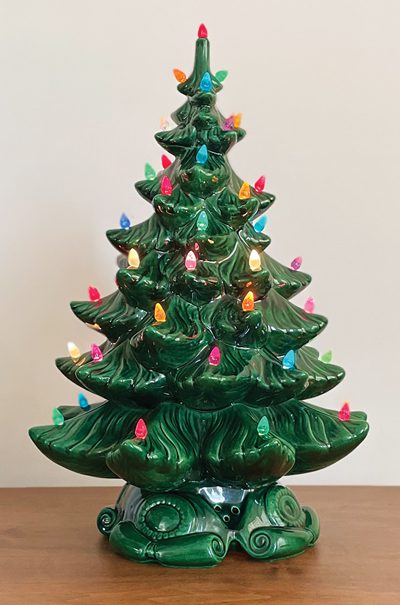Christmas Past
Writer Ren MillerCeramic trees shine again
If there’s ever a time for nostalgia, it’s Christmas. Those who celebrate the season treasure their memories of happy gatherings, familiar carols, favorite meals and colorful decorations. Vintage decorations, in particular, are tangible keepsakes that remind us of Christmases past and the people who made them meaningful.
“Existing outside the time in which they were first made and used, [vintage decorations] can inspire and connect people today,” famed ornament designer Christopher Radko says in his forward to Vintage Christmas, a book written by Bob Richter and published by Globe Pequot. “[Vintage decorations are] a highly creative and personal way of affectionately embracing our legacies.”
One vintage decoration that made a comeback during the pandemic as we sheltered in place — and longed for simpler times — is the ceramic Christmas tree. The trees reminded us of our mothers, grandmothers and aunts who made them during the heyday of a ceramics craft movement that began in the 1950s and boomed through the 1960s.
The trees fed an appetite created by two socioeconomic factors:
• Americans who came of age in the 1950s grew up during the Great Depression, when holiday decorations tended to be made by hand rather than purchased. That continued even as the economy prospered after World War II. At the same time, interest in holiday décor expanded beyond Christmas trees and wreaths into all types of tabletop items.
• Women proved their mettle in the workplace when taking over for men who left to serve in the war. When the war ended in 1945, however, many turned their jobs over to returning veterans. Social activities gave these newly unemployed women a reason to escape the house; magazines of the time were filled with tips on garden, card and other types of parties. Ceramics studios jumped on the trend and invited women — sometimes men attended but less often — to create and paint decorative items that were then glazed and fired to a shiny brilliance.
Christmas trees quickly became the darling of ceramics fans. Although based on designs from the 1940s, when artists handcrafted the trees and wired each light individually, they became easier to make with the introduction of reusable molds that resulted in detailed, repeatable designs. The new trees had holes in the branches to hold colorful plastic bulbs shaped like a flame (and later birds or stars). A matching ceramic platform supported the tree and was wired for a regular household light bulb to illuminate the whole tree rather than wiring each light.
The trees became de rigueur for 1950s through 1960s holiday décor — all sizes and colors (especially green, green with white-tipped branches, white and pink); with or without glitter; sometimes all one color of lights and other times mixed. Some have a plastic star inserted into the top.
By the 1970s, however, ceramics were on the decline. Women joined the workforce in bigger numbers, leaving less time for social activities. An influx of ready-made imports reduced interest and value. Many mold-making firms and ceramics studios couldn’t remain competitive and either consolidated or closed. (Some ceramics studios still exist; search online to find one near you.)
Today, if you have a ceramic Christmas tree from the 1950s-1970s, it no doubt has sentimental value. Thanks to renewed interest, it may have monetary value as well, depending on size, condition and age. Larger trees in pristine shape sell for premium prices on websites such as Etsy and eBay, where prices in late October rose as high as $2,159 for an unusually tall tree (33 inches). More common sizes (12 to 18 inches) in excellent condition were offered around $200-$500. Prices typically rise as Christmas approaches.
Two notes: (1) Be aware it’s hard to know a tree’s age unless the maker inscribed the date by hand. That’s different from an imprinted date, which indicates when the mold was made, not the tree. Some molds made in 1958 are still in use, so a brand-new tree could bear a 1958 imprint. (2) If your tree is missing some of the colored plastic inserts, check for them at crafts stores or online.
Then sit back and enjoy your Christmas memories once again.
The Real Thing
The nature-produced trees that inspired ceramic trees have an interesting New Jersey connection. What is believed to be the very first farm devoted just to growing Christmas trees was in Hamilton Township, Mercer County. W.V. McGalliard planted 25,000 Norway spruce trees in 1901 and started to sell them seven years later for $1 each (equivalent to about $35 today).

